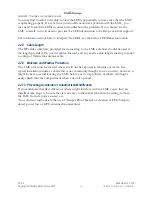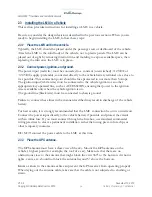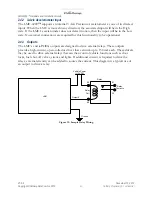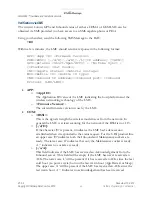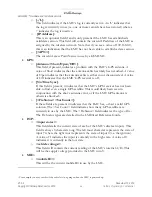
LMU-4200™ Hardware and Installation Guide
V1.0.9
November 13, 2010
Copyright ©CalAmp DataCom Inc 2010
- 16 -
CalAmp Proprietary & Confidential
2.3
Installing the LMU in a Vehicle
This section provides instructions for installing an LMU in a vehicle.
Be sure to consider the design decisions described in the previous sections. When you are
ready to begin installing the LMU, follow these steps:
2.3.1
Place the LMU unit in the vehicle.
Typically, the LMU should be placed under the passenger seat or dashboard of the vehicle.
Attach the LMU to the solid body of the vehicle, not to plastic panels. The LMU can be
placed out of sight by removing interior trim and molding to expose available space, then
replacing the trim once the LMU is in place.
2.3.2
Connect power, ignition, and ground.
The power input (red wire) must be connected to a constant (un-switched) +12 VDC or
+24 VDC supply; preferably, connected directly to the vehicle battery terminal or as close to
it as possible. This connection point should be fuse protected to not more than 5 Amps.
The ignition input (white wire) must be connected to the vehicle ignition or another
appropriate key operated line, such as ACCESSORY, ensuring that power to the ignition
wire is available only when the vehicle ignition is on.
The ground line (black wire) must be connected to chassis ground.
Failure to connect these lines in the manner described may result in discharge of the vehicle
battery.
For best results, it is strongly recommended that the LMU connection be on its own circuit.
Connect the power input directly to the vehicle battery if possible and protect the circuit
with an inline fuse. If you must connect through the fuse box, use standard commercial
wiring practices to create a permanent installation rather than using press-in fuse clips or
other temporary measures.
DO NOT connect the power cable to the LMU at this time.
2.3.3
Place the GPS antenna.
The GPS antenna must have a clear view of the sky. Mount the GPS antenna on the
vehicle’s highest point (for example, the roof of a car). Make sure that there are no
obstructions close to the antenna that might block the view 360° to the horizon. Air horns
lights, vents, etc.. should not block the antenna beyond 5° above the horizon.
Kinks or knots in the antenna cable can prevent the GPS receiver from operating properly.
When laying out the antenna cable, take care that the cable is not subjected to crushing or
strain.














